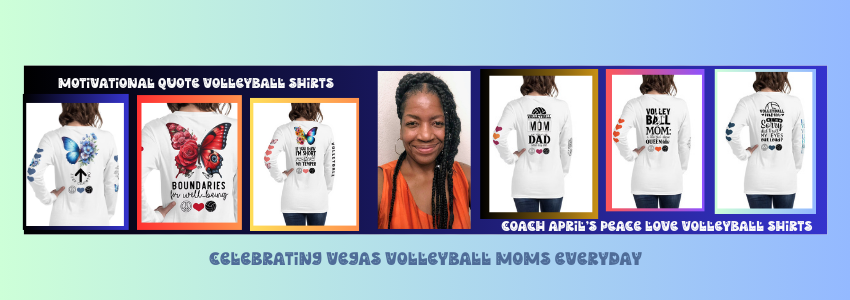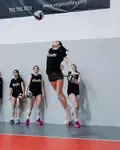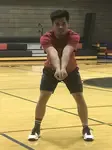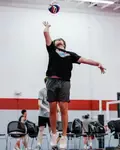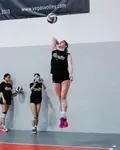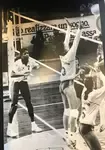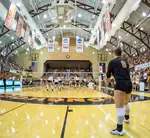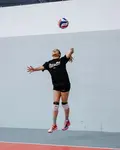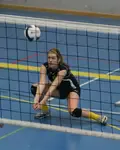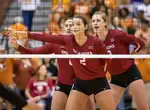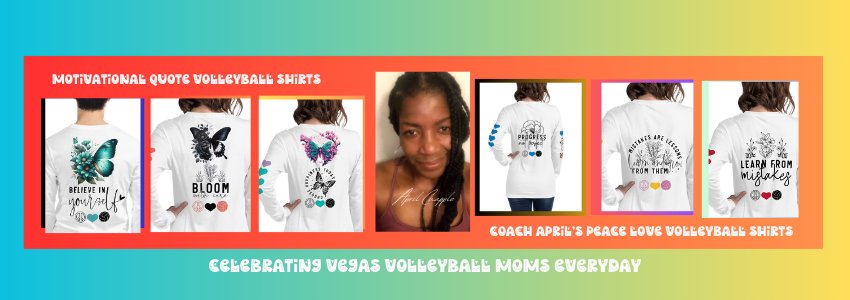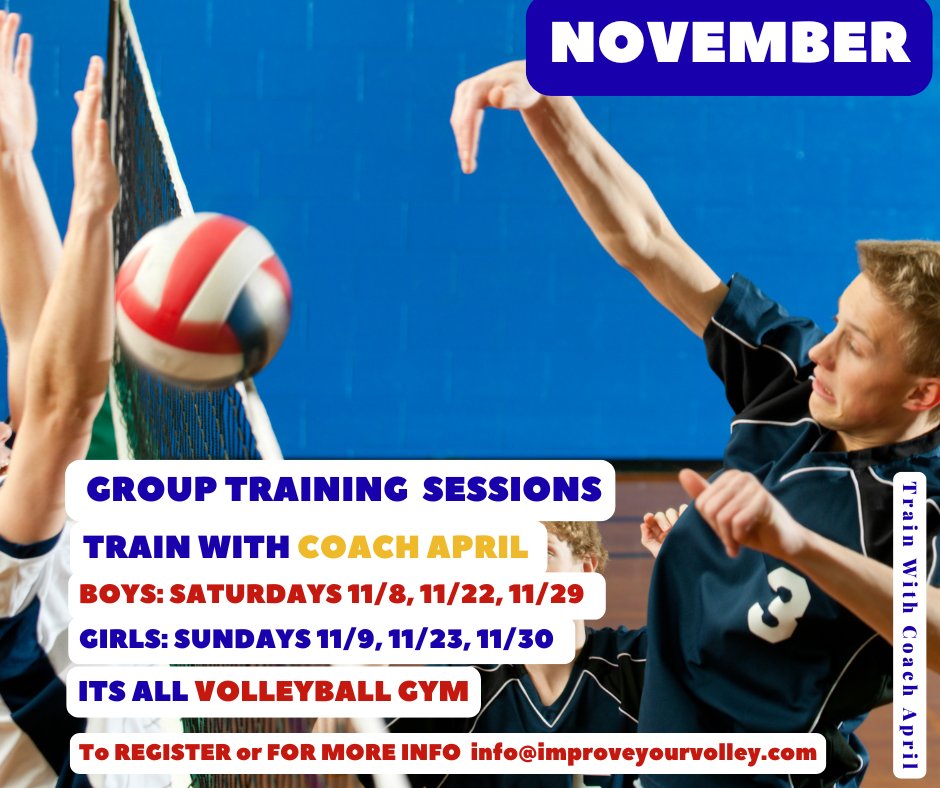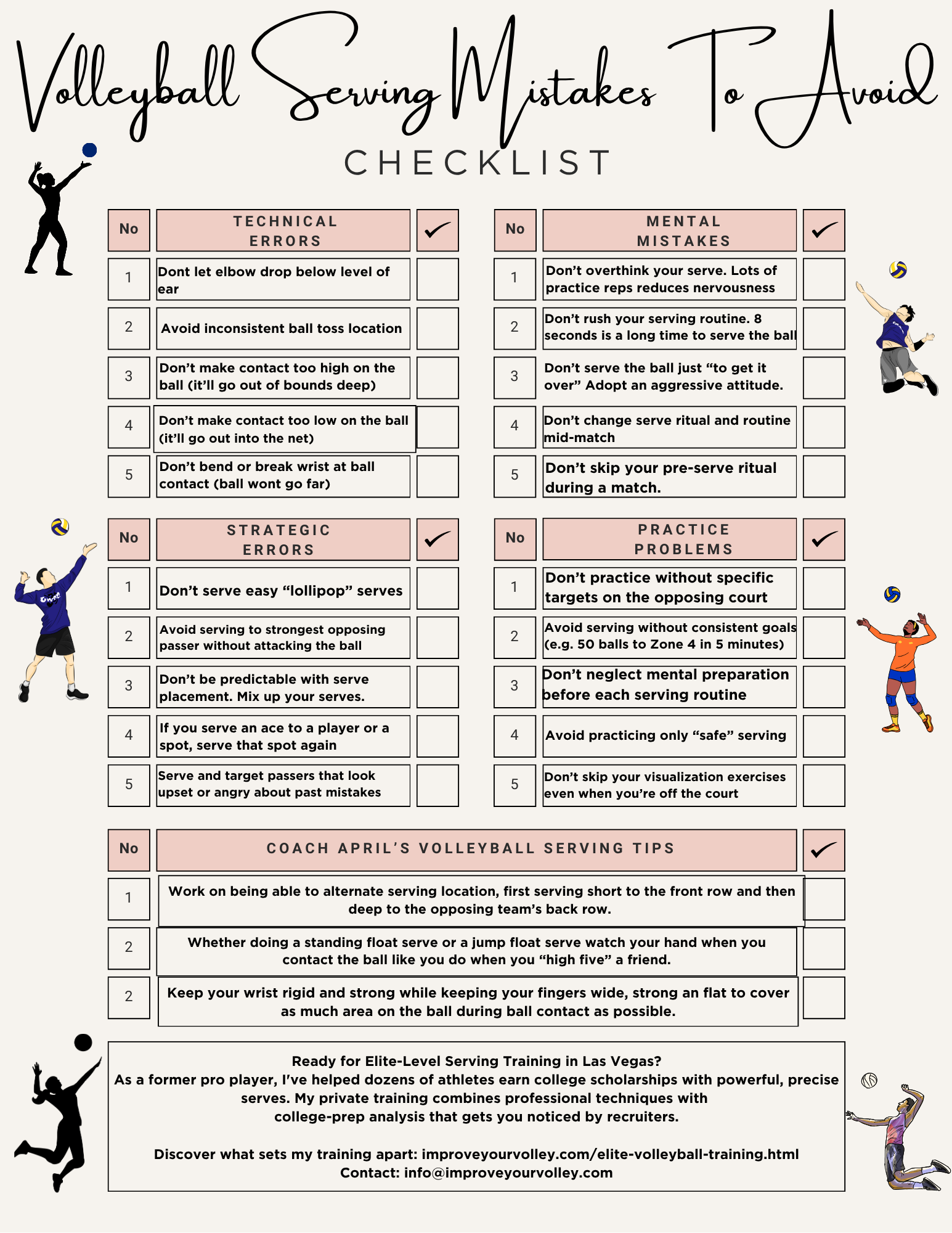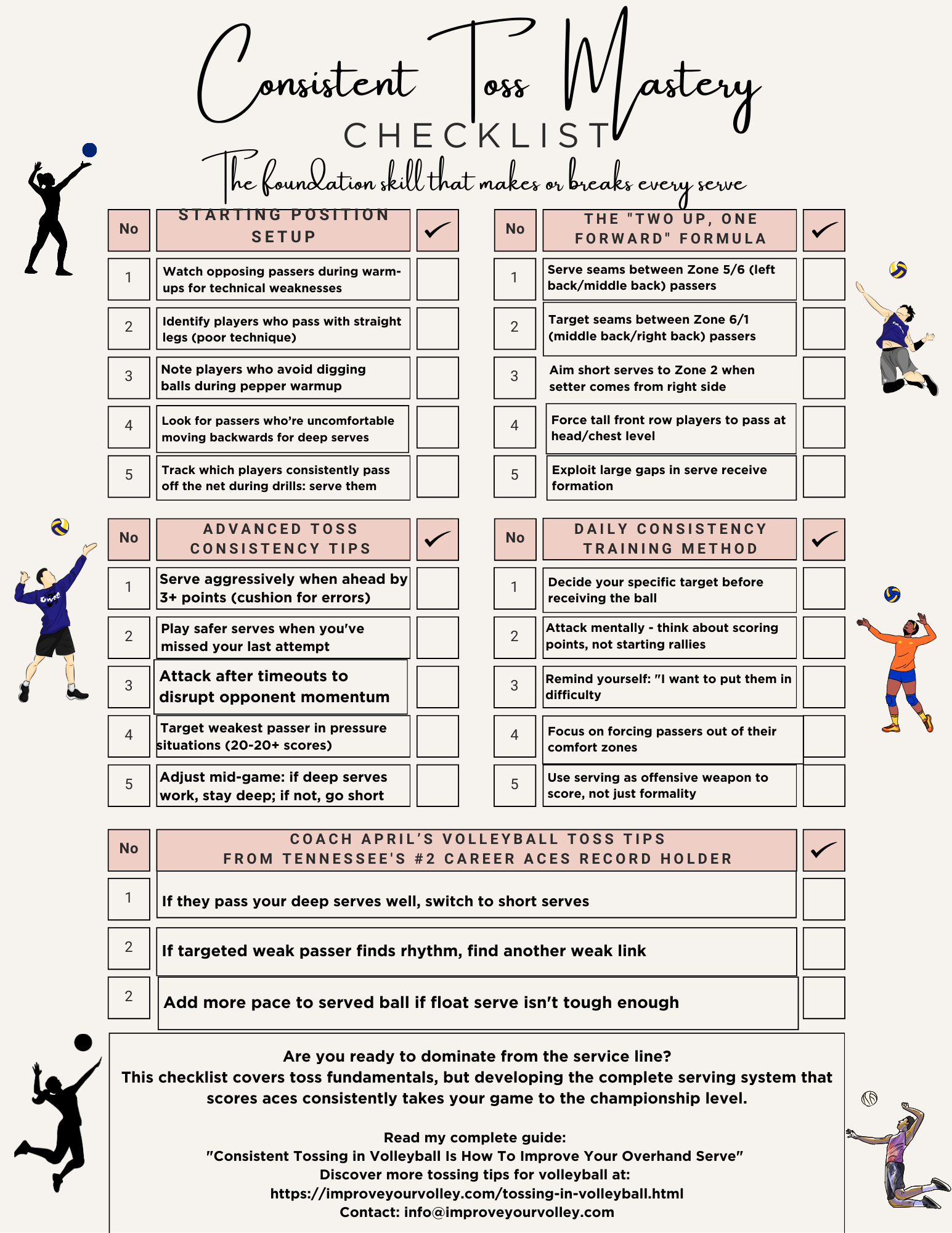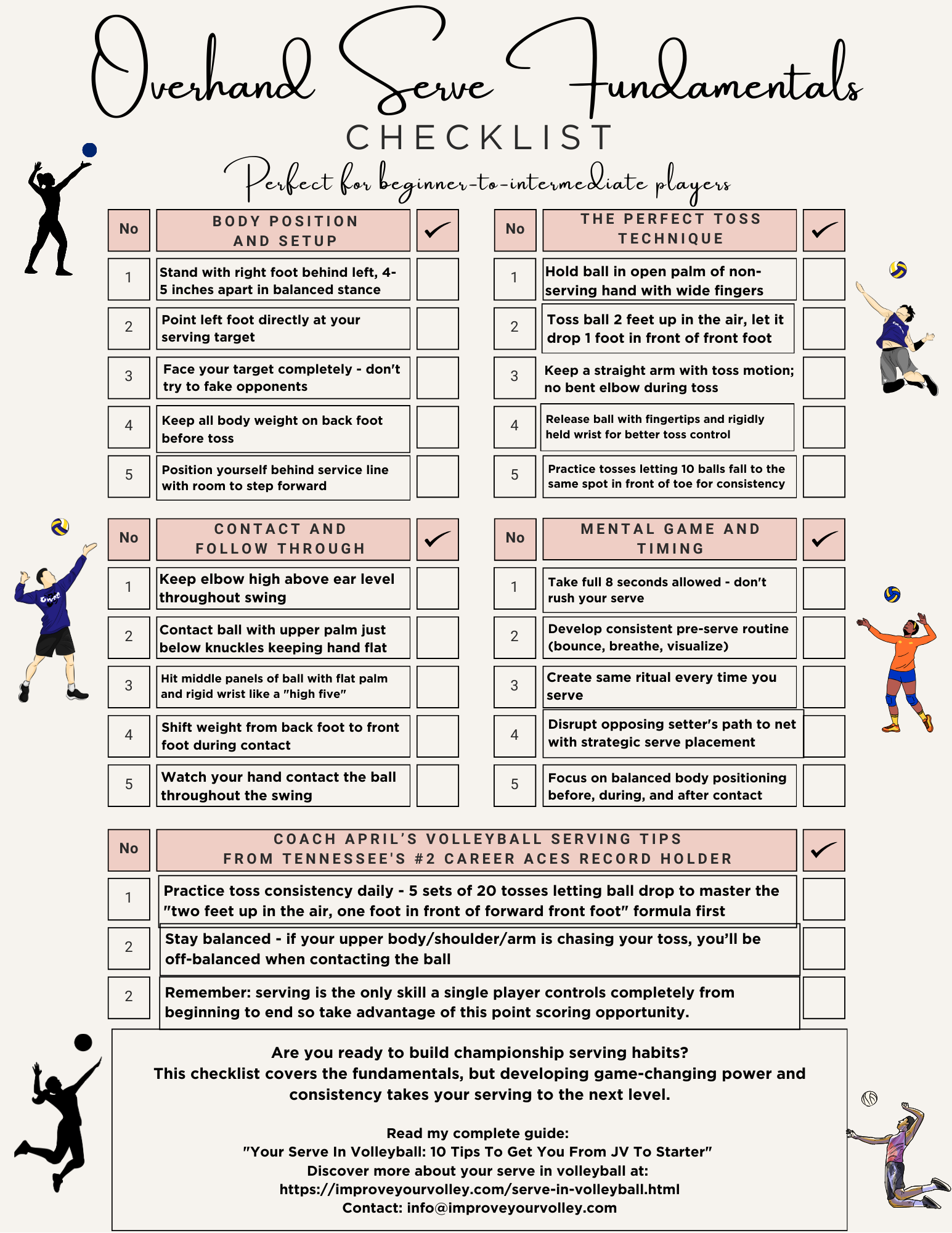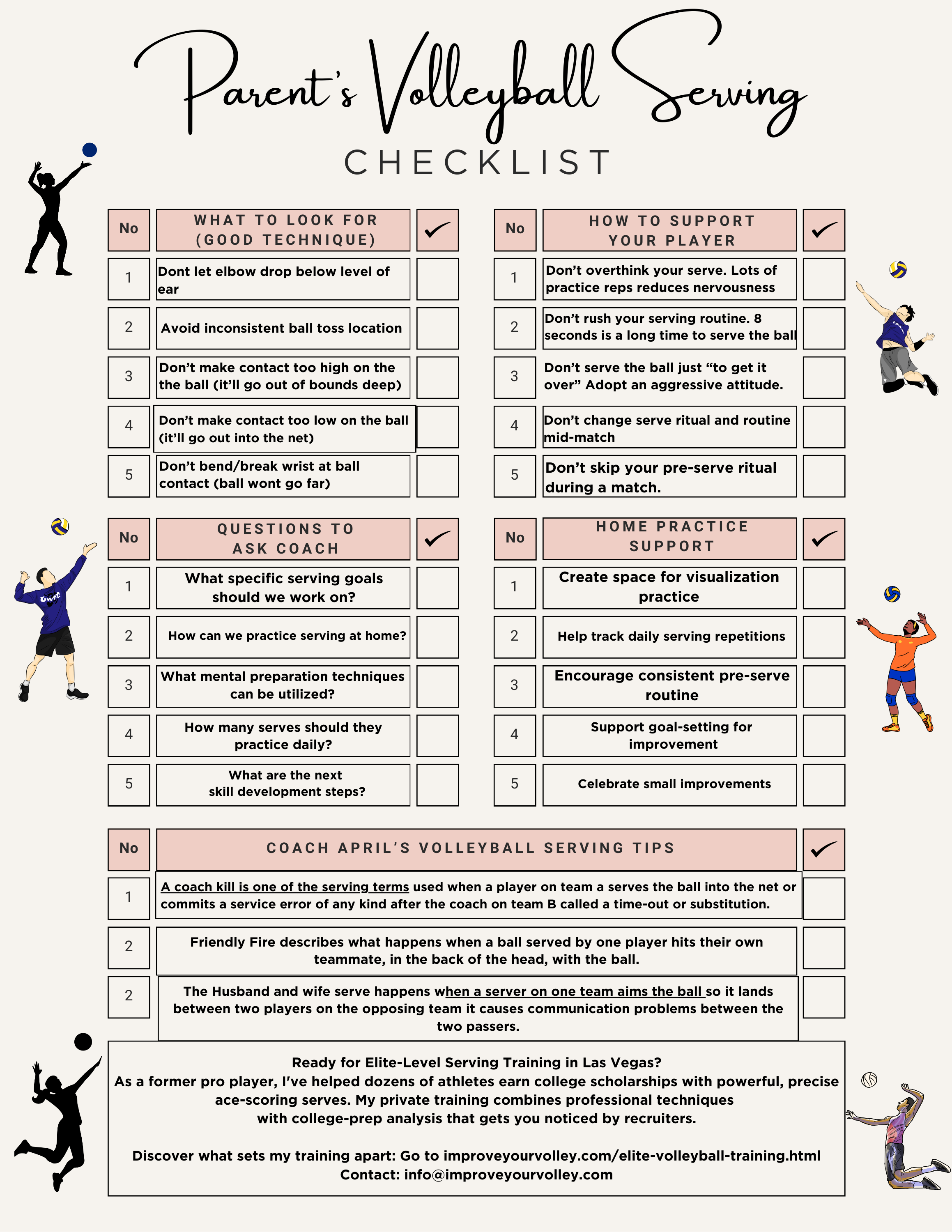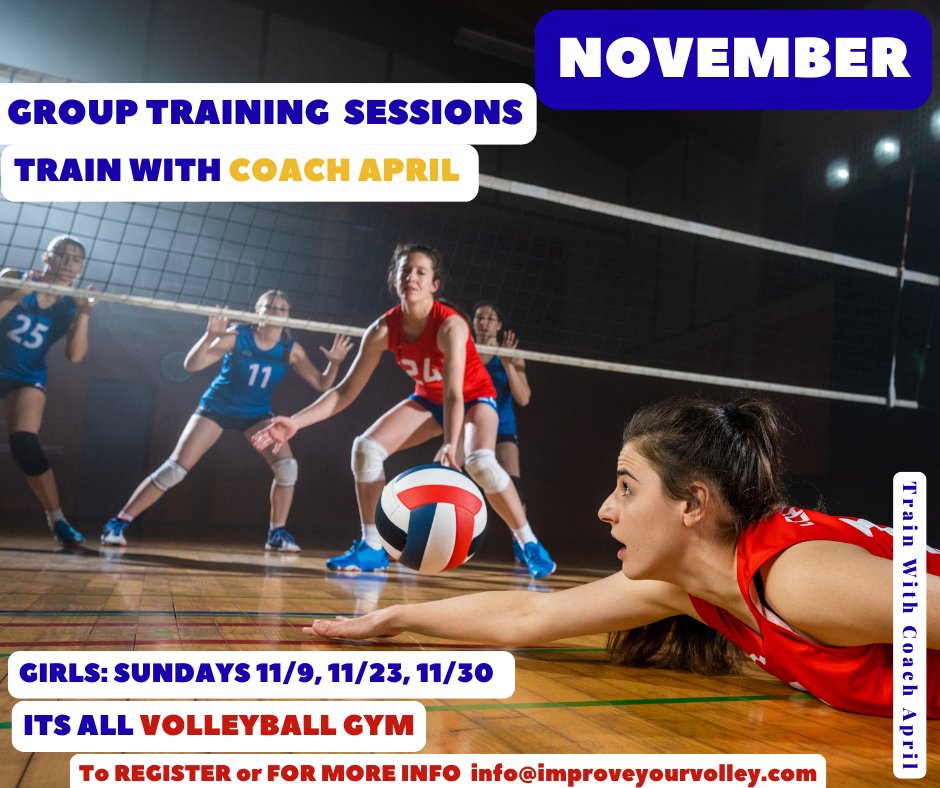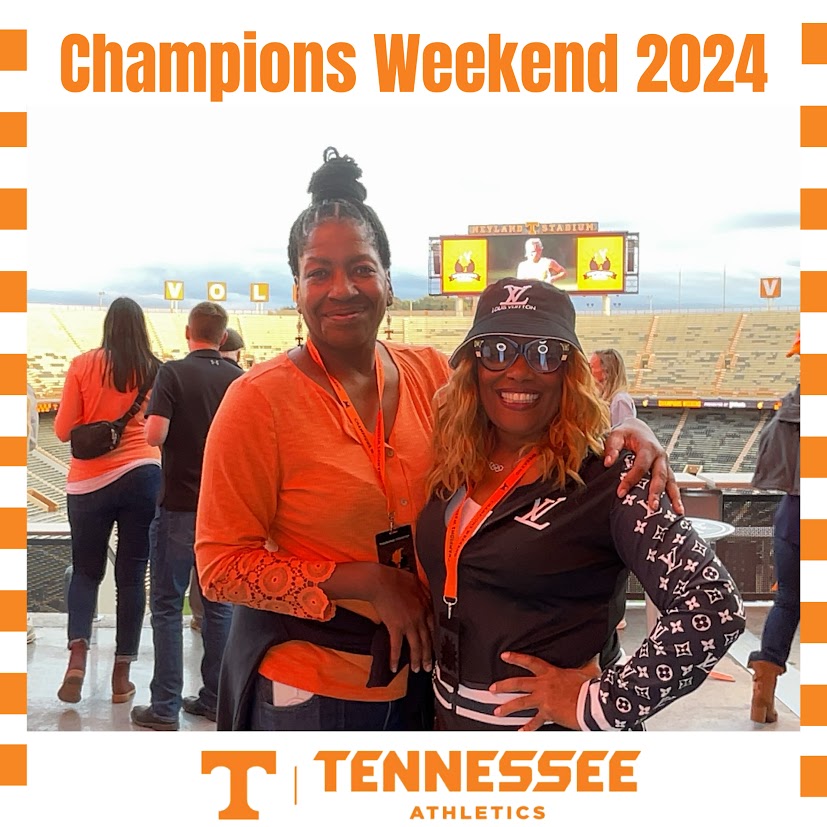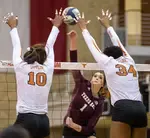- Improve Your Volleyball with Coach April
- High School Varsity Volleyball
- Dig in Volleyball
The Dig In Volleyball 8 Steps On How To Get A Ball Up When On Defense
Learn the 8 technical aspects of how to dig in volleyball in the backcourt while your high school varsity volleyball team is on defense so you dig hard hitters.
How To Dig In Volleyball
Ready Position
- In the back row you should be in an athletic stance with knees slightly bent, leaning slightly forward so your shoulders are in front of your knees with hands and arms extended in front of you 3-4 inches in front of your knees
- Just before you have to dig in ball, keep your hands apart so you can run, shuffle step or move quickly to the ball once you know where the ball is going to possibly land
- Quickly clasp hands together using the same hand grip as you do when you pass...one fist placed inside the palm of the other hand, both thumbs side by side together then pointed towards the ground
- During the dig keep thumbs pointed to the floor, which keeps your arms straight and creates a nice flat platform which you use to dig the ball up into the air
Liberos must be passing masters. Grab a pair or two of volleyball digging sleeves covers the techniques that make great liberos elite.
- Before contacting the ball your hips have to be below the level of the oncoming ball. This is what helps lift the ball up into the air and increases the chances of it staying on your side.
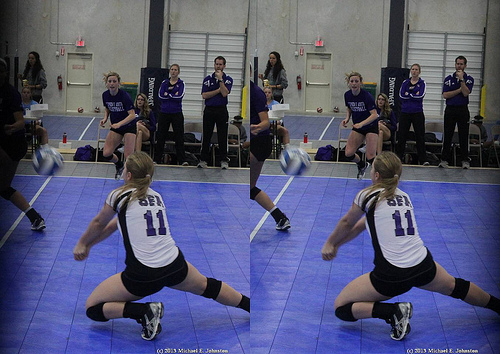 Before contacting the ball drop your hips below the oncoming ball. This lifts the ball in the air and keeps it in the air and on your side. (Stephen F Austin)
Before contacting the ball drop your hips below the oncoming ball. This lifts the ball in the air and keeps it in the air and on your side. (Stephen F Austin)- When contacting or "digging" the ball, do not swing your arms to meet the ball. The attack hit is hard enough and you don't need to add additional movement to get the ball up.
- Angle your platform to the target where you want the ball to go and let the ball bounce off your platform.
- The trick is to use your straight armed platform to present the correct angle so the ball goes right to the target you are aiming for.
How To Dig In Volleyball
Why Learn How To Be A Good Digger On Your Varsity Volleyball Team?
To dig in volleyball or by digging a volleyball up in defense you are keeping an attacked ball by the opposing team off your court floor.
How To Dig In Volleyball
What does to 'dig a volleyball' mean?
To dig in volleyball means you contact and intercept the ball, while your team is on defense by deflecting it up in the air with your arms held together.
You defend, or dig the ball to keep it off your team's court floor once it crosses into your court after an attack hit by the opposing team, so they don't score a point .
There are offensive ways to contact the ball and there are defensive ways to contact the ball.
The 'pass', the 'set', the 'serve' and the 'hit' describe offensive ways to contact the ball. These are terms that describe ways you contact the ball to set it up for an attack hit into the other team's court.
The "block" and "the dig" are defensive terms used to describe ways to contact the ball.
You 'block' or 'dig a ball' when you need to defend your court from the other team's attack.
With practice reps and plenty of defensive drills you will learn how to use your arms so they absorb the impact of hard hit balls.
Liberos run the backrow! Celebrate your position with this libero volleyball shirt designed for the defensive backs of volleyball.
Common Mistakes to Avoid When Performing a Dig
While learning to master the dig, many beginners make errors that could hinder their performance. Here are some common mistakes you need to watch out for:
1. Improper Stance:
Many beginners neglect the importance of maintaining an athletic stance. Remember, you need to have knees slightly bent and leaned forward with your shoulders in front of your knees. This helps you move quickly and effectively to respond to an attack.
2. Swinging Arms:
Attempting to meet the ball by swinging your arms can result in a loss of control over the direction of the dig. The goal is to let the ball bounce off your platform, not to swing your arms to hit it.
3. Incorrect Hand Position
Thumbs pointed towards the ground helps to keep your arms straight. An incorrect hand grip can create an uneven platform, leading to an ineffective dig.
4. Lack of Defensive Readiness
Always be prepared to run, shuffle step, or move quickly to the spot where the ball is likely to land. If you aren't prepared to move quickly, your digs may end up being ineffective.
Liberos run the backrow! Celebrate your position with this libero volleyball shirt designed for the defensive backs of volleyball.
5. Failing to Angle Your Platform
This is one of the most common beginner mistakes - contacting the ball square to the net instead of angling the platform to your target. Having a clear vision of where you want the ball to go and angling your platform accordingly is crucial to a successful dig.
Avoiding these common mistakes doesn't only increase your ability to execute a good dig, it also boosts your overall defensive game.
And remember, practice makes perfect, so don't be bummed by initial errors – they're just stepping stones on your path to becoming an excellent digger.
Do You Follow Me on Pinterest?
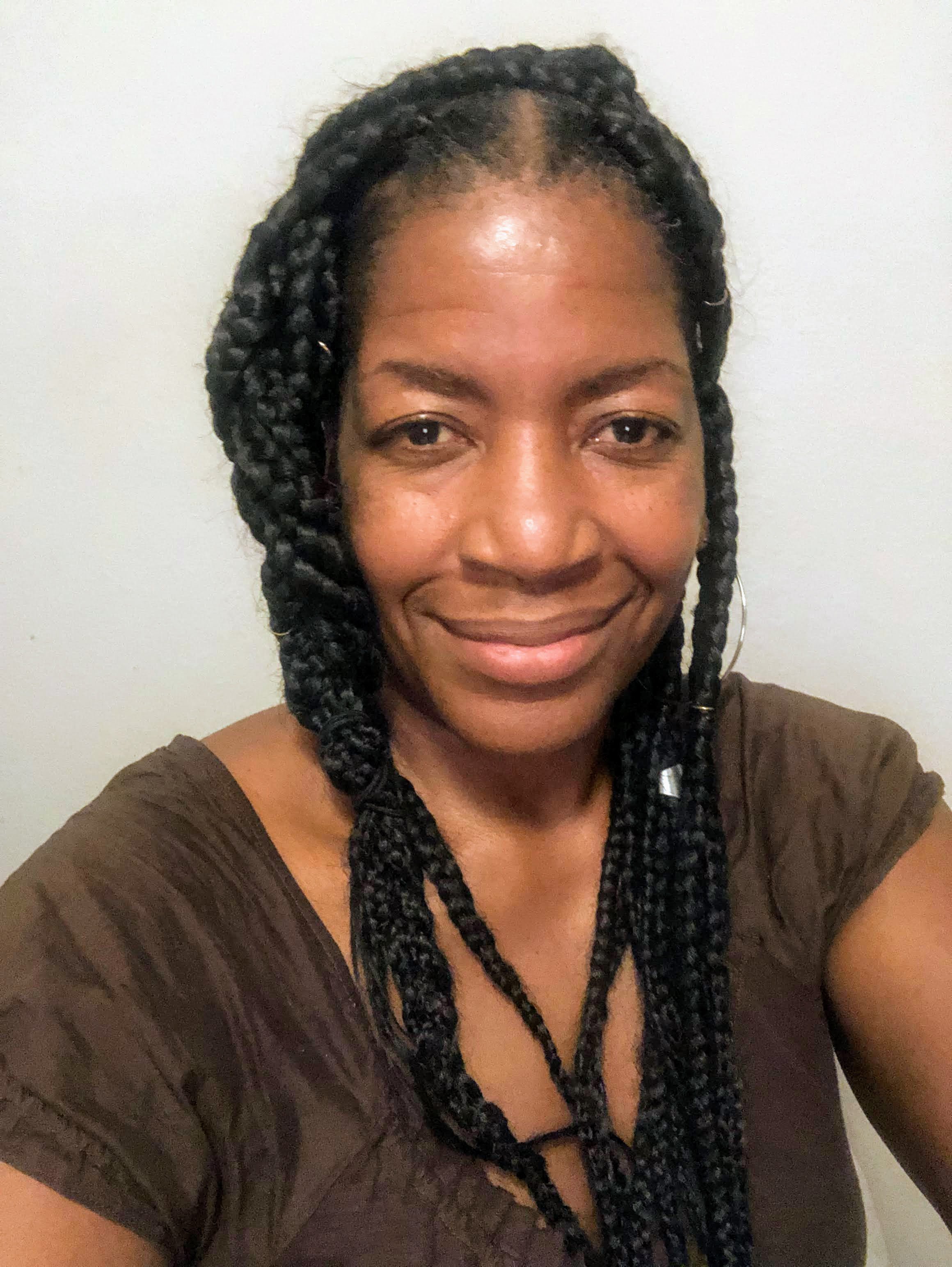 Private or semiprivate volleyball indoor/sand lessons are an excellent way for young Las Vegas high school volleyball players to quickly improve their individual skills through a private or semi-private coaching experience.
These lessons are conducted by former pro volleyball player, former USA Volleyball High Performance instructor and Evaluator and Tstreet Vegas 18s head Coach April Chapple on a weekly basis.
Sign up now!
Private or semiprivate volleyball indoor/sand lessons are an excellent way for young Las Vegas high school volleyball players to quickly improve their individual skills through a private or semi-private coaching experience.
These lessons are conducted by former pro volleyball player, former USA Volleyball High Performance instructor and Evaluator and Tstreet Vegas 18s head Coach April Chapple on a weekly basis.
Sign up now!Follow me on Pinterest Volleybragswag to improve your game even faster!
I share alot of individual, partner and easy-to-do volleyball serving drills we do in class with my followers.
Many of these volleyball practice drills you can do at home by yourself or try at your next practice with your teammates.
If you're a B team or JV player trying to make varsity next year...your goal should be to complete 1000 reps a day of at least three of the basic skills on your own...volleyball passing, serving and setting should be at the top of the list.
How To Dig In Volleyball:
Where Do You Go Now?
Okay here's where you need to go now! There are three options:
- Learn more about How to Dig In Volleyball and Defense by clicking the Related Links below. .
- Follow the suggested reading on our Sitemap page Learning How To Play (Sitemap)
- Or visit the pages in the How to Play Volleyball section in the drop down menu at the top of the page to get started.
If your athlete struggles with consistent serve receive, gets subbed out, or is overlooked for playing time—this is the fix you’ve been looking for.

Struggling with passing consistency?
I help talented passers tired of getting pulled from games because of inconsistent serve receive skills BUILD passing confidence without expensive private lessons using the same 3-step system that's helped dozens of my athletes get recruited.
Download my eBook for $17.99 and start building the passing confidence that keeps you on the court—and gets you seen by college coaches.
From Lady Vol to Legend: Coach April Produces Powerful Passionate Players...is that you?
What Are You Looking For?
Click to Download Your Pre Serving Ritual Mastery Checklist pdf:
🎯Volleyball Pre Serving Ritual Guide -
Players! Learn How To Transform Your Serve from Weak to Weapon
Click to Download Your Parent's Volleyball Serving Checklist pdf
🎯Parent's Volleyball Serving Checklist Guide
Parents! Help Your Player Develop Championship Serves (Even If You've Never Played)

Hi there!
Thanks for stopping by. Hope you learned something today that will help you reach your volleyball goals.
Be sure to subscribe to my email newsletter so you can learn more each week!
Stay strong! Stay motivated!
-Coach April
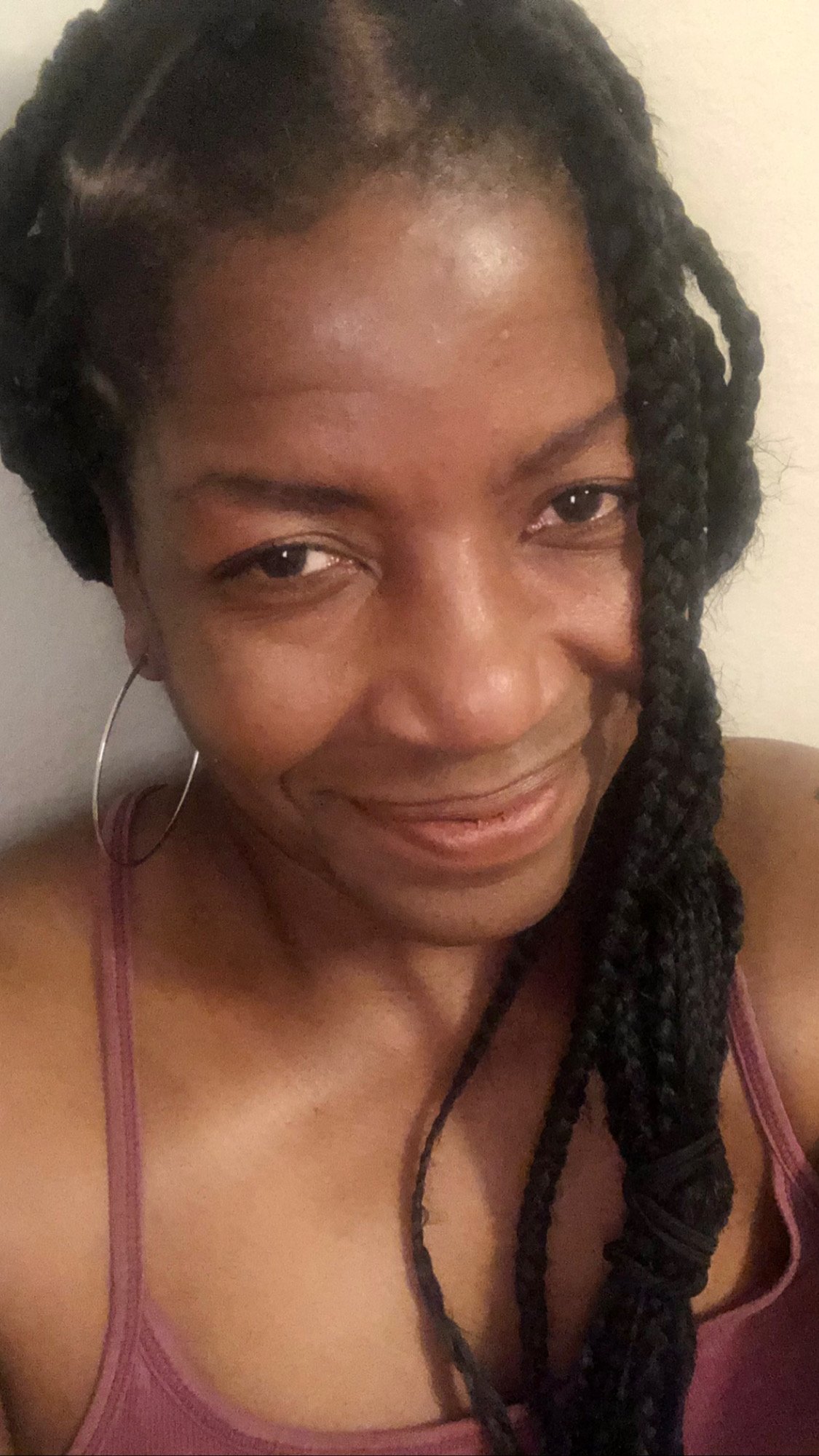
SUSCRIBE to my email newsletter below!
 Click to learn more about the weekly volleyball classes and clinics or email info@imrpoveyourvolley.com for information
Click to learn more about the weekly volleyball classes and clinics or email info@imrpoveyourvolley.com for informationCongratulations to my seven Boys-18s Vegas Volley club players who played in two state championship finals yesterday, the 3A and 5A State champinship finals at Sunrise Mountain High School.
TOURNAMENT CHAMPIONS!
A-1 Vegas Volley VBC
In It To Win It Tournament
May 2 - 4, 2025 Tournament
Gold Medalists
18s Premier Division
Vegas Volleyball's Unsung Heroes: Celebrating Moms with Peace Love Volleyball Shirts
Ready to energize your volleyball mom journey?
Subscribe to my 'Producing Powerful Passionate Peaceful Players' email list above on ImproveYourVolley.com.
You'll receive energy-boosting tips, exclusive insights from me, Coach April Chapple on maintaining momentum in volleyball.
Let's power up the Vegas volleyball scene together!
Recent Articles
-
Tips For Short Volleyball Players: Top Strategies to Beat Big Blockers
Jan 11, 26 11:00 PM
You don't need to be 6 feet tall to dominate at the net. Learn my tips for short volleyball players to use to outsmart bigger blockers and score more points. -
Essential Skills for a Hitter in Volleyball: Tips For Short Attackers
Jan 11, 26 07:05 AM
A short hitter in volleyball can aim the ball for the seam of the block to score since its harder for defenders to block at the net or dig up in the back row. -
10 Hitting Tactics Short Volleyball Players Use Against Big Blockers
Jan 11, 26 06:57 AM
These are 10 hitting tactics that short volleyball players, can rely on hit against and sideout and score against teams with big blockers in the front row.


